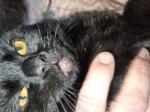Things to Know About Cat Scratch Fever
Cat scratch fever is the common name for an infectious disease known as cat scratch disease, or CSD.
Although the symptoms of CSD may range from mild to severe, it is typically not serious.
Immunosuppressed patients are at higher risk for more severe symptoms and related illnesses.
Cat scratch fever gets its name from its usual origin: a scratch, or more rarely, a bite from an infected cat.
The first symptom to appear is often a brownish skin lesion, resembling an insect bite, in the area of the wound.
The skin lesion, which may or may not have pus or fluid associated with it, may appear within three to ten days.
This is followed by painful swelling in the the lymph nodes within one to two weeks, sometimes with fever.
This disease is self-limiting, and usually resolves on its own in the majority of patients. Despite this, it may take from two to five months for the the swollen lymph nodes to subside, and up to two years for the lesions to clear up.
Although there has been some controversy surrounding its root cause, CSD is known to be caused by a bacterium called Bartonella henselae.
Of the 22,000 cases diagnosed each year, most of the infections occur in the fall and winter to people under the age of 21. Many more cases may go unrecognized, undiagnosed, and unreported.
Fleas have been found to spread the bacteria from cat to cat, but not to humans. Kittens and younger cats are more likely to become infected.
Once a cat is infected, the bacteria can live in the cat's saliva for months. Infected cats and carriers do not normally show any symptoms of illness.
Methods of Transmission
Cat scratches or bites are the primary method of transmission to humans, but a lick from a cat on an open wound can have the same result.
In addition, cats are not the only source of cat scratch fever.
In fact, some patients have claimed to have had no recent contact with a cat. Cases of cat scratch disease have been reported in patients who have been scratched by dogs, goats, squirrels, porcupine quills, crab claws, cactus spines, and barbed wire.
There have been some reports that declawing may reduce the chances of transmission, but most expert sources agree that this does not, if at all, dramatically reduce your risk.
Note: Declawing is a severe procedure requiring partial amputation (they don't just take the claws out as the name implies) or cutting of the tendon, and delivers questionable benefit in almost all circumstances. Talk to your veterinarian about the alternatives, and consider nail caps/covers, scratching posts, and Feliway.
Prevention
While reports vary, it is believed that almost half of all cats have a Bartonella henselae infection at some time in their lives.
Like all infectious diseases, prevention of cat scratch fever involves limiting your exposure. The good news is, that for most people, infection will be mild. For the immunosuppressed, things could be more serious.
Since kittens and younger cats are more likely to carry the disease, reducing your exposure reduces your risk. In fact, some advise that those at high risk should only adopt an adult cat into the home.
Additional Recommendations
Eliminate fleas in order to keep cats from becoming infected. I recommend using natural flea control on a regular basis to keep the flea problem in check without exposing your pets to dangerous chemicals.
Do not do anything that encourages a cat to scratch or bite, such as playing rough with your hands or arms (that's what cat toys are for!). If your cat is ankle biting, use appropriate behavior modification techniques to curb that or other aggressive behavior.
Wash cat bites and scratches as soon as possible with antibacterial soap and water. Follow proper first aid procedures to prevent infection. Do not allow your cats to lick any open wounds or scratches.
If you develop any of the following symptoms, contact your health care provider:
- Infection at the site of a cat scratch or bite
- Fever
- Headache
- Swollen lymph nodes
- Fatigue
Click here to read more about the symptoms of this disease.



Comments: What do you think?
Have your say about what you just read. Leave me a comment in the box below.